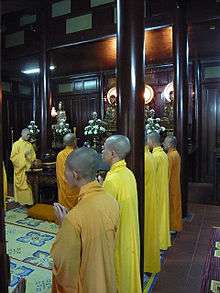Vietnamese Thiền
Thiền Buddhism (Vietnamese: Thiền Tông, 禪宗, IPA: [tʰîən təwŋm]) is the Vietnamese version of Chan Buddhism (popularized in English as the Japanese Zen Buddhism). Thiền is the Sino-Vietnamese pronunciation of Chan (Chinese: 禪; pinyin: chán) an abbreviation of 禪那 (chánnà), which is a Chinese transliteration of the Sanskrit word of dhyāna ("meditation").
| Part of a series on |
| Zen Buddhism |
|---|
 |
|
Persons Chán in China Classical
Contemporary
Zen in Japan Seon in Korea Thiền in Vietnam Zen / Chán in the USA Category: Zen Buddhists |
|
Doctrines
|
|
Awakening |
|
Practice |
|
Schools
|
|
Related schools |
History
Chinese Chan Buddhism was introduced during the early Chinese domination of Vietnam, 111 BCE to 939 CE, which also accommodated local animism and Cham influences.[1] According to traditional accounts, in 580, an Indian monk named Vinītaruci (Vietnamese: Tì-ni-đa-lưu-chi) who is considered the founder of Thiền, traveled to Vietnam after completing his studies with Sengcan, the third Patriarch of Chan. However, Chan was already present in the country before his arrival. "Thien Buddhism was already established in Vietnam before Vinītaruci's arrival, for Phap Hien studied under and was ... After Vinītaruci's death, Phap Hien built the Temple of Chung-thien at Mount Tu, about twenty miles northwest of Luy-lau."[2]
The sect that Vinītaruci and his lone Vietnamese disciple founded would become known as the oldest branch of Thiền. After a period of obscurity, the Vinītaruci School (Diệt Hỉ Thiền phái; 滅喜禪派) became one of the most influential Buddhist groups in Vietnam by the 10th century, particularly so under the patriarch Vạn-Hạnh (died 1018). Other Thiền schools were founded during this time, such as the Pháp Vân temple lineage.[3] Other early Vietnamese Thiền schools included that of the Chinese monk Wu Yantong, called Vô Ngôn Thông in Vietnamese, which was associated with the teaching of Mazu Daoyi. Information about these schools can be gleaned from a Chinese language hagiographical work entitled Thiền uyển tập anh "Compendium of Outstanding figures of the Chan Garden", c. 1337.[4] A careful study of the primary sources by Cuong Tu Nguyen however concludes that the legend of Vinītaruci and the accounts of Vô Ngôn Thông are probably fabrications, a version of Vietnamese Buddhist history that "was self-consciously constructed with the composition of the Thiền uyển in medieval Vietnam."[5][6] Cuong Tu Nguyen notes that the kind of Buddhism which was practiced in Vietnam during the Chinese occupation period and before the writing of the TUTA was "a mixture of thaumaturgy, asceticism, and ritualism" which was "very worldly engaged."[5]
Whatever the case, Buddhist culture, literature, arts and architecture thrived during the period of peace and stability of the four Vietnamese dynasties of the Earlier Lê, Lý, Trần and the Later Lê (980-1400).[7][8] During the early Lê and Lý periods, Buddhism became an influential force in court politics and the dynastic elites saw Buddhist clergy as useful assistants in their political agenda which they provided in return for patronage. They were eventually integrated into the structure of the imperial state.[9] During the Lý and Trần dynasties, a "new" court Buddhism arose among the elites which was aligned with Chinese Chan and influenced by Chan literature.[10] Some of the Trần rulers were quite involved in the development of Thiền Buddhism. Trần Thái Tông (1218–77) was known as the "Great Monk King" and wrote various important Buddhist works including Lessons in the Void, A Guide to Zen Buddhism and a Commentary on The Diamond Sutra, as well as poetry.[7]
The first truly Vietnamese Thiền school was founded by the religious emperor Trần Nhân Tông (1258–1308), who became a monk. This was the Trúc Lâm or "Bamboo Grove" school, which evinced a deep influence from Confucian and Taoist philosophy.[1] It seems to have been an elite religion for aristocrats and was also promoted by Chinese monks who traveled to Vietnam to teach.[11] Nevertheless, Trúc Lâm's prestige waned over the following centuries after the Ming conquest (1413-1428) which led to a period of Confucian dominance.[1]
In the 17th century, a group of Chinese monks led by Nguyên Thiều established a vigorous new school, the Lâm Tế, based on the Linji school, which mixed Chan and Pure Land Buddhism.[1] A more domesticated offshoot of Lâm Tế, the Liễu Quán, was founded in the 18th century by a monk by the name of Liễu Quán. Lâm Tế remains the largest monastic order in the country today.[12]
Vietnamese Buddhism suffered from political oppression during the colonial era of French Indochina, both by pro-Confucian mandarins and French colonial policies.[1]
Modern Vietnamese Thiền was influenced by the Buddhist modernism of figures like Taixu and D. T. Suzuki, who saw Buddhism in terms of social and personal transformation, rather than in supernatural terms.[13] During the 1930s, a Buddhist reform movement led by intellectual clergy of "engaged Buddhism" focused on issues such as welfare activities, education and modernization. The modernization movement also argued against popular devotion, arguing that Buddhism should be "purified from superstition".[14] In 1963, in response to a hostile government, Vietnamese Mahayana and Theravada Buddhists formed the Unified Buddhist Church.[1] Thích Trí Quang led South Vietnamese Buddhists in acts of civil resistance in protest of the South Vietnamese government's repression of Buddhists during the "Buddhist crisis" of '63.

.jpg)
Thiền master Thích Thanh Từ (1924–) is credited for renovating Trúc Lâm in Vietnam. He is one of the most prominent and influential Thiền masters currently alive. He was a disciple of Master Thích Thiện Hoa. The most famous practitioner of modern Thiền Buddhism in the West is Thích Nhất Hạnh (1926–) who has authored dozens of books and founded the Plum Village Monastery in France together with his colleague, Thiền Master bhikkhuni Chân Không. Another influential teacher in the West was Thích Thiên-Ân, who taught philosophy at University of California, Los Angeles and founded a meditation center in L.A.
In recent years, the modernization of Thiền has taken a new global dimension, as Vietnamese Zen is becoming influenced by the teachings of influential overseas Vietnamese Buddhist leaders such as Thích Nhất Hạnh who have adopted Thiền to Western needs. As a result, Vietnamese Buddhists have also now begun to practice these modernized forms of Thiền.[15]
This modernist form of Thiền has become quite popular at home and abroad, in spite of the fact that there is still no complete freedom of religion in contemporary Vietnam.[16] Commenting on the current situation in Vietnam, Philip Taylor writes:
The flow of Buddhist practitioners, texts and ideas throughout Vietnam and across national boundaries sets the context for another recent development in Buddhism in Vietnam, the increasing prominence given in northern Vietnam to Zen (Thiền) as the quintessential Vietnamese Buddhist tradition....Southern Vietnam's intense transnational connections have enabled the repatriation and the circulation to elsewhere in Vietnam of the markedly meditative form of Buddhism developed by Vietnamese emigre monks based in the United States and France...Ironically, this recently imported purified form of Buddhism has come to be taken as a national tradition, a view which receives endorsement from the state, motivated, as are many lay Buddhists, to attach itself to an authentic national tradition that is not sullied by the taint of superstition....Today, the Communist Party seeks to boost its legitimacy by endorsing Zen a version of Buddhism promoted by a transnational movement, as an authentic national tradition.[17]
Teaching and practice

Thiền draws its texts and practices mainly from the Chinese Chan tradition as well as other schools of Chinese Buddhism. According to Thích Thiên-Ân:
most Buddhist monks and laymen in Vietnam traditionally obey the disciplines of Hinayana, recite mantra, learn mudra, practice meditation, and chant the Buddha's name (V. niệm Phật, Ch. Nien-fo, J. Nembutsu) without any conflict between the practices. We may say, in short, that Buddhism in Vietnam is synthetic and unified rather than divided and sectarian. At present the popular method of practice is meditation during recitation and recitation during meditation - meditation and recitation being one and the same for Vietnamese Buddhists.[18]
This practice is known as the "union of Zen and Pure-Land recitation".[18] The chanting of sutras, such as the Lotus sutra, the Vimalakirti, Surangama Samadhi and Mahaparinirvana sutra is also a very widespread practice, as in all schools of Zen.[19]
Due to the presence of Theravada Buddhism in Vietnam, Thiên has also been influenced by Theravada practices. The intra-religious dialogue between Vietnamese Theravada and Mahayana following the formation of the Unified Buddhist Church also led to a more inclusive attitude in the Vietnamese Buddhist community.[7] An example is the widely influential figure of Thích Nhất Hạnh (b. 1926), who, as John Chapman notes, though being part of the Lam Te school, also included Theravada as part of his studies.[20] Thích Nhất Hạnh has also written commentaries on the Theravada Satipatthana sutta and the Anapanasati sutta. According to Chapman, Hạnh has sought to "promote the idea of a humanistic, unified Buddhism."[20] He founded the Order of Interbeing as a new modernist and humanistic form of Vietnamese Zen.
McHale also notes that Vietnamese Buddhist practice has always been inclusive and accepting of popular beliefs and practices, including folk religion, Taoism and Confucianism.[21]
See also
References
- Johnston, William M. (editor), Encyclopedia of Monasticism, p. 276.
- Keith Weller Taylor, The Birth of Vietnam 1983, p. 157
- K. W. Taylor, John K. Whitmore; Essays Into Vietnamese Pasts, Cornell University Press, 2018, p. 103.
- K. W. Taylor, John K. Whitmore; Essays Into Vietnamese Pasts, Cornell University Press, 2018, p. 81.
- K. W. Taylor, John K. Whitmore; Essays Into Vietnamese Pasts, Cornell University Press, 2018, pp. 102, 107.
- Cuong Tu Nguyen, Zen in Medieval Vietnam: A Study and Translation of the Thiền uyển tập anh, University of Hawaii Press, 1997, p. 21.
- Dietrich, Angela, The Roots of Interbeing: Buddhist Revival in Vietnam
- Thích Quảng Liên, "A Short Introduction of Buddhism in Vietnam", 1968.
- Cuong Tu Nguyen, Zen in Medieval Vietnam: A Study and Translation of the Thiền uyển tập anh, University of Hawaii Press, 1997, p. 13-14.
- Cuong Tu Nguyen, Zen in Medieval Vietnam: A Study and Translation of the Thiền uyển tập anh, University of Hawaii Press, 1997, p. 19.
- Cuong Tu Nguyen, Zen in Medieval Vietnam: A Study and Translation of the Thiền uyển tập anh, University of Hawaii Press, 1997, p. 21.
- Powers, John, A Concise Encyclopedia of Buddhism, Oneworld Publications, 2013 , p.238
- Borup, Jørn; Qvortrup Fibiger, Marianne; Eastspirit: Transnational Spirituality and Religious Circulation in East and West, BRILL, 2017, p. 168.
- Hanna Havnevik, Ute Hüsken, Mark Teeuwen, Vladimir Tikhonov, Koen Wellens (ed.), Buddhist Modernities: Re-inventing Tradition in the Globalizing Modern World, Taylor & Francis, 2017, p. 189.
- Hanna Havnevik, Ute Hüsken, Mark Teeuwen, Vladimir Tikhonov, Koen Wellens (ed.), Buddhist Modernities: Re-inventing Tradition in the Globalizing Modern World, Taylor & Francis, 2017, p. 189.
- Hanna Havnevik, Ute Hüsken, Mark Teeuwen, Vladimir Tikhonov, Koen Wellens (ed.), Buddhist Modernities: Re-inventing Tradition in the Globalizing Modern World, Taylor & Francis, 2017, pp. 183, 188.
- Hanna Havnevik, Ute Hüsken, Mark Teeuwen, Vladimir Tikhonov, Koen Wellens (ed.), Buddhist Modernities: Re-inventing Tradition in the Globalizing Modern World, Taylor & Francis, 2017, p.188.
- Thich Thien-an, Buddhism & Zen in Vietnam: In Relation to the Development of Buddhism in Asia, Tuttle Publishing, 1992, p. 3.
- Andronic, Mihaela, To be is to inter-be, Philosophical Teachings of Thích Nhất Nhất Hạnh, 2011.
- Chapman, John, The 2005 Pilgrimage and Return to Vietnam of Exiled Zen Master Thich Nhat Hanh, in: Taylor, Philip Modernity and Re-enchantment: Religion in Post-revolutionary Vietnam.
- McHale, Shawn F., Print and Power: Confucianism, Communism and Buddhism in the Making of Modern Vietnam, 2004
External links
- Vietnamese Zen
- Sweeping Zen: Vietnamese Zen Teachers
- Plum Village - Thich Nhat Hanh's main monastery and practice center, located about 85 km east of Bordeaux, France